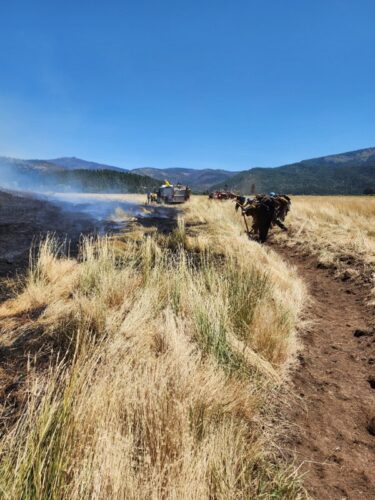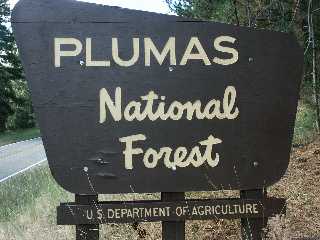With a dry cold front moving into the area, gusty winds and another human caused wildfire today, firefighters on the Plumas National Forest are asking area residents and visitors to help prevent wildfires.
Early this afternoon, firefighters responded to the Stampfli Fire in Indian Valley. Structures were threatened. The fire is human caused and under investigation.

By midafternoon the fire was contained at 6.3 acres due to the fast response and hard work by Plumas National Forest and cooperating agency firefighting resources. This included multiple engines, a water tender, a hotshot crew, dozer, helicopter, two air tankers, air attack, a fire investigator from CAL FIRE Lassen Modoc Unit and several support positions.
In addition to the Plumas National Forest, firefighting resources included Indian Valley Volunteer Fire Department, the Greenville Rancheria engine and non-federal cover resources brought in by the Plumas National Forest.
Firefighters are working on mop-up and control is expected later tonight.
“I want to thank everyone that was part of the robust response to the Stampfli Fire this afternoon, making sure the fire was quickly contained and that no homes were lost,” said Plumas National Forest Fire Management Officer Martin Senter.
The fire was burning in oak and grass woodland with reported wind gusts over 30 mph.
“The Stampfli Fire could have been much worse, especially driven by the strong, gusty winds that started in the area this morning,” Senter said. “The weather today and through the weekend includes a Red Flag Warning on the eastern edge of the Forest, a Fire Weather Watch near the western side of the Forest and strong wind gusts predicted in between, so it’s critical to use caution with anything that can start a fire.”
Since 2021, fire seasons on the Plumas National Forest have started relatively late and fires have been kept small, with last summer’s 3,000-acre Gold Complex being the largest fire on the Forest since the 2021 Dixie Fire.
An average snowpack this winter melted quickly this spring. This has resulted in drier conditions, but also thicker grass and brush growth. As they dry out, these fine fuels can carry fire quickly.
“We aren’t meeting the scientific thresholds to go into fire restrictions yet, but we are close,” Senter said. “The fires we have been responding to are what we usually see in July, not mid-June.”
Additionally, after several years, the large wildfire burn scars are increasingly at risk of re-burning.
“As was the case with the Letter Fire last week in the 2020 North Complex burn scar, it’s more difficult and extremely hazardous to fight fires in burned areas,” Senter said. “It takes longer to contain and control fires in these areas due to standing dead trees, dense fuels on the ground and potential of rolling materials including logs and rocks creating dangerous conditions for firefighters.”
While the Plumas National Forest has work occurring for community protection and post-fire forest recovery, the focus for wildland firefighters is full suppression and public and firefighter safety.
“This isn’t the time for our local residents and Forest visitors to get complacent with fire,” Senter said. “While our firefighters and partners have done a great job keeping fires small for the past several years, with how the past couple months have gone, I am concerned about what is ahead of us in July, August and September.”
Area residents and visitors should be careful with anything that can spark a wildfire and report suspected wildfires to 911.
For more information on the Plumas National Forest, visit www.fs.usda.gov/plumas or on Facebook at www.facebook.com/USFSPlumas.





